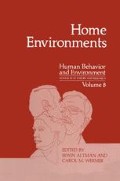Abstract
This chapter discusses theoretical and methodological principles with respect to the analysis of home environments. It defines and illustrates those principles that form the nucleus of an analytical method that employs an historical or temporal perspective. I believe that this approach can enrich our comprehension of domestic environments.
The organization of thought and of social relations is imprinted on the landscape. But, if only the physical aspect is susceptible of study, how to interpret this pattern would seem to pose an insoluble problem.
—Douglas, 1972, p. 513.
Access this chapter
Tax calculation will be finalised at checkout
Purchases are for personal use only
Preview
Unable to display preview. Download preview PDF.
References
Altman, I., Vinsel, A., & Brown, B. Dialectical conceptions in social psychology: An application to social penetration and privacy regulation. In L. Berkowitz (Ed.), Advances in experimental social psychology (Vol. 14 ). New York: Academic Press, 1981, pp. 107–160.
Berry, D., & Gilbert, S. Pioneer building techniques in South Australia. Adelaide: Gilbert Partners, 1981.
Bourdieu, P. Outline of a theory of practice. Cambridge: Cambridge University Press, 1977.
Boyd, R. Australia’s home: Its origins, its builders and occupiers. Ringwood, Victoria: Penguin Press, 1968.
Burnett, J. A social history of housing 1815–1970. Newton Abbot, England: David and Charles, 1978.
Cobb, R. The tempting threshold. The Listener, 6 April 1978, pp. 438–439.
Coloquhoun, A. Sign and substance: Reflections on complexity, Las Vegas and Oberlin. Oppositions, Fall 1978, 14 26–37.
Csikszentmihalyi, M., & Rochberg-Halton, E. The meaning of things: Domestic symbols and the self. New York: Cambridge University Press, 1981.
Daunton, M. Experts and the environment: Approaches to planning history. Journal of Urban History, 1983, 9 (2), 233–250.
Douglas, M. (Ed.). Rules and meanings. Harmondsworth: Penguin Press, 1966.
Douglas, M., & Isherwood, Baron The world of goods New York: Basic Books, 1979.
Elliott, J. Manuscript catalogue number D2759L held in the State Archives of South Australia. Adelaide: 1860. S. Pikusa (Ed.), Joseph Elliott’s cottage of 1860 with architectural commentary. Sydney: The Flannel Flower Press, 1984.
Freeland, J. Architecture in Australia: a history. Ringwood, Victoria: Penguin Press, 1972.
Hareven, J. (Ed.). Transitions: The family and the life course in historical perspective. New York: Academic Press, 1978.
Narré, R. Social being: A theory of social psychology. Oxford: Blackwell, 1979.
Hodder, E. The history of South Australia. London: Sampson, Low and Marston, 1893.
Ladd, F. Residential history: You can go home again. Landscape, 1977, 22 (3), 15–20.
Lawrence, R. L’espace domestique: typologie et vécu. Cahiers Internationaux de Sociologie 1982, 22 (1), 55–75.
Lawrence, R. The comparative analyses of homes: Research method and application. Social Science Information,1983, 22(3), 461–485. (a)
Lawrence, R. Understanding the home environment: Spatial and temporal perspectives. International Journal for Housing Science and its Applications, 1983, 7 (1), 13–25.
Leach, E. Culture and communication: The logic by which symbols are connected. Cambridge: Cambridge University Press, 1976.
Leach, E. Social anthropology. London: Fontana, 1982.
Le Roy Ladurie, E. Montaillou: Cathars and Catholics in a French village 1294–1324. Harmondsworth: Pergamon Books, 1980.
Lévi-Strauss, C. The scope of anthropology. London: Allen Lane, 1967.
Lynch, K. What time is this place? Cambridge, Mass.: M.I.T. Press, 1972.
Pevsner, N. A history of building types. London: Thames and Hudson, 1976.
Porter, H. The watcher on the cast iron balcony: An Australian autobiography. London: Faber and Faber, 1963.
Pratt, G. The house as an expression of social worlds. In J. Duncan (Ed.), Housing and identity: Cross-cultural perspectives. London: Croom Helm, 1981, pp. 181–197.
Quatremère de Quincy, A. De l’imitation. Paris: Editions de Paris, 1823.
Sumner, R. The tropical bungalow: The search for an indigenous Australian architecture. Australian Journal of Art, 1978, 1, 27–30.
Swenarton, M. Homes fit for heroes. London: Heinemann Educational Books, 1981.
Twopenny, R. Town life in Australia. London: Elliot Stock, 1883.
Author information
Authors and Affiliations
Editor information
Editors and Affiliations
Rights and permissions
Copyright information
© 1985 Springer Science+Business Media New York
About this chapter
Cite this chapter
Lawrence, R.J. (1985). A More Humane History of Homes. In: Altman, I., Werner, C.M. (eds) Home Environments. Human Behavior and Environment, vol 8. Springer, Boston, MA. https://doi.org/10.1007/978-1-4899-2266-3_5
Download citation
DOI: https://doi.org/10.1007/978-1-4899-2266-3_5
Publisher Name: Springer, Boston, MA
Print ISBN: 978-1-4899-2268-7
Online ISBN: 978-1-4899-2266-3
eBook Packages: Springer Book Archive

